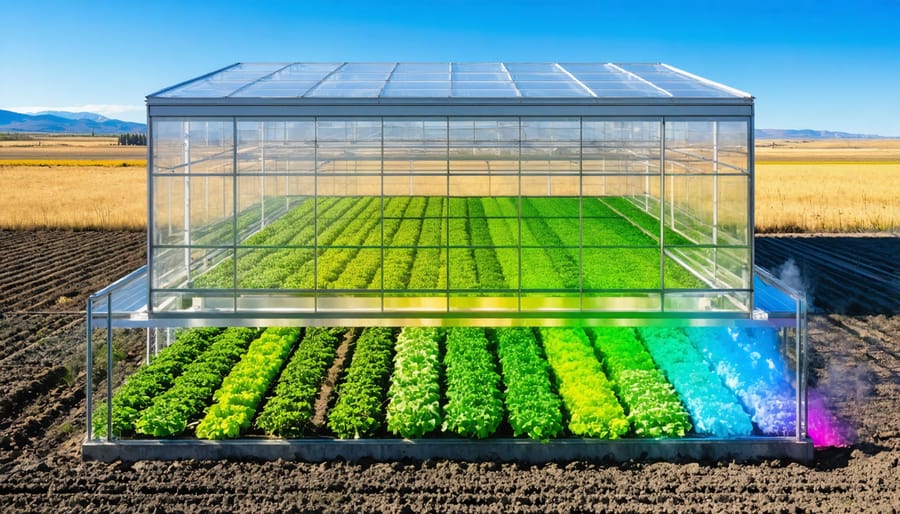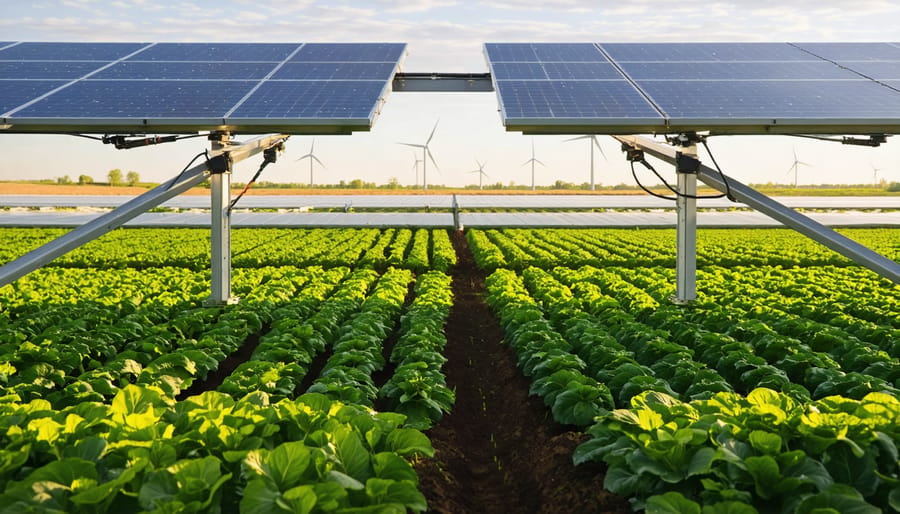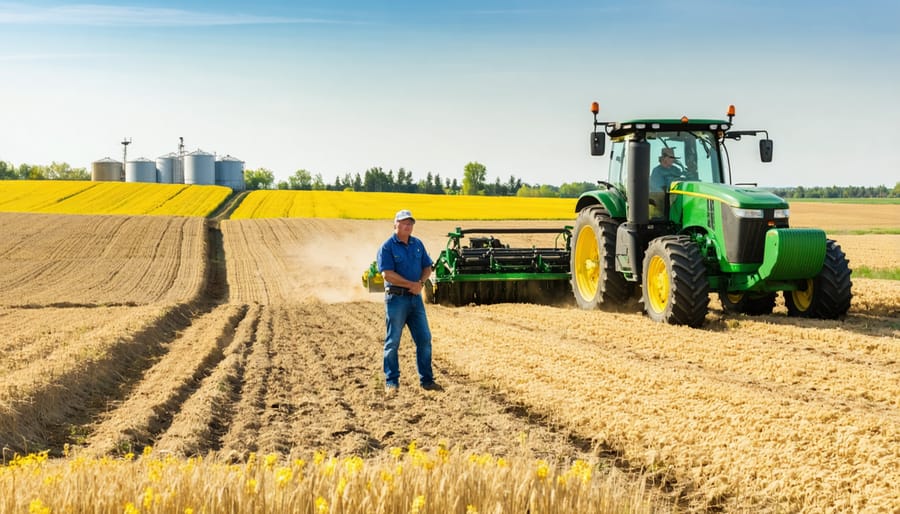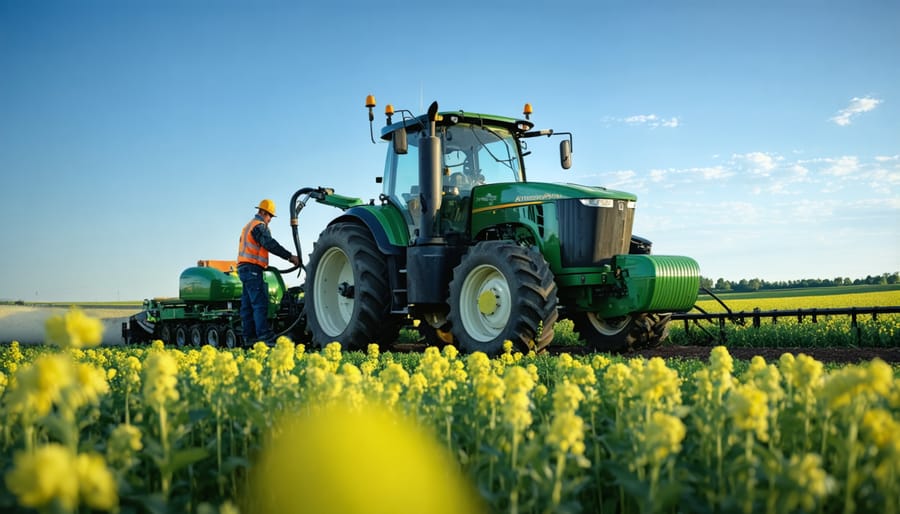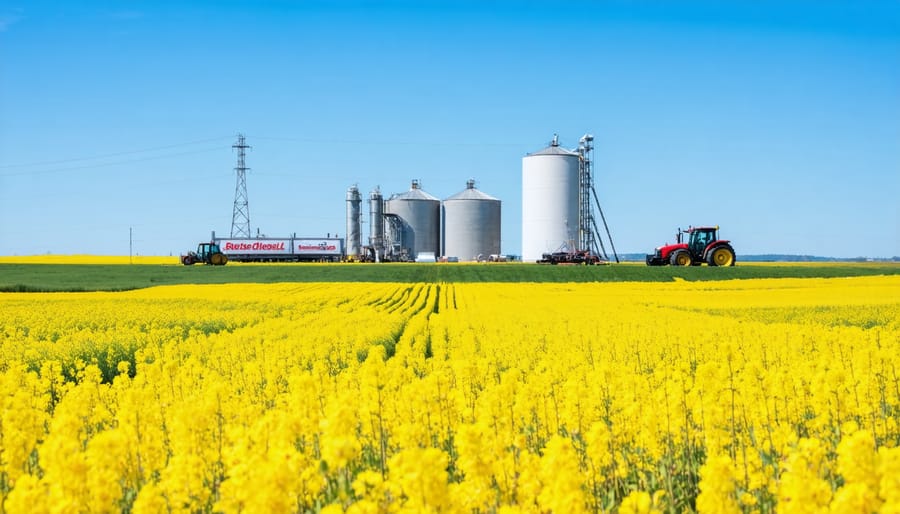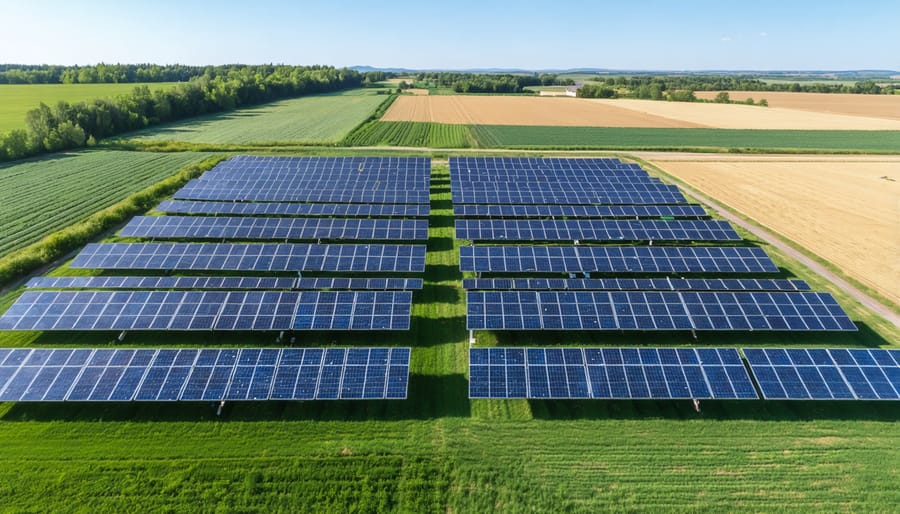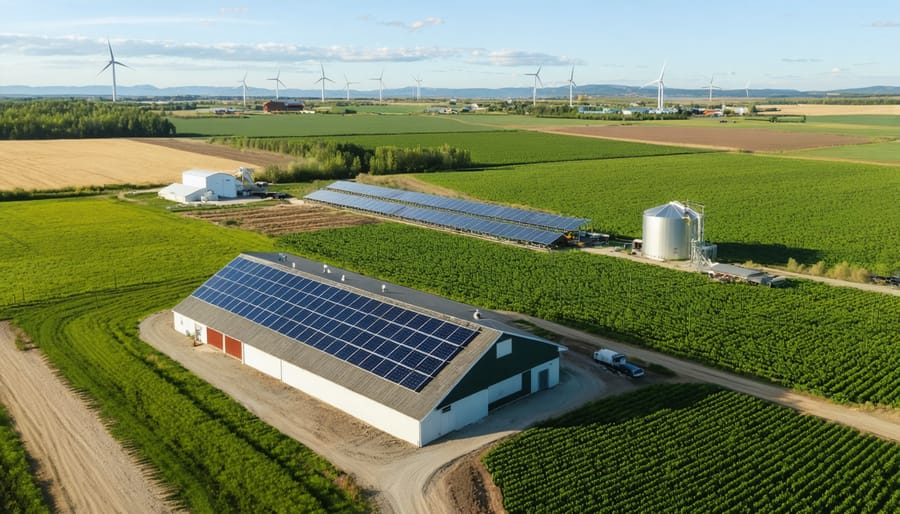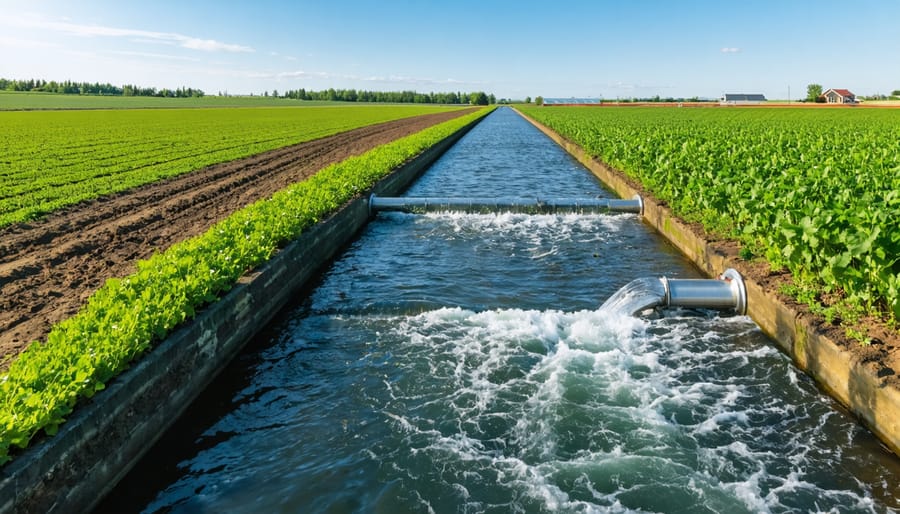Geothermal energy powers millions of homes and businesses across five continents, with Iceland leading the global charge by meeting over 90% of its heating demands through Earth’s natural heat. This renewable powerhouse has transformed entire economies, from New Zealand’s sprawling greenhouse operations to Turkey’s rapidly expanding district heating systems. In North America, California’s Geysers complex stands as the world’s largest geothermal installation, while Canadian developments in Alberta and Saskatchewan demonstrate how this technology adapts to diverse geological conditions. For Canadian farmers and agricultural operators, geothermal energy represents a sustainable solution for greenhouse heating, crop drying, and year-round food production, offering potential energy cost reductions of 40-60% compared to conventional systems. As global energy demands shift toward sustainable solutions, understanding where and how geothermal energy thrives becomes crucial for making informed investments in our agricultural future.
Leading Global Agricultural Applications of Geothermal Energy
Iceland’s Greenhouse Revolution
Iceland has revolutionized greenhouse agriculture through its masterful use of geothermal energy, turning this cold northern country into a year-round producer of fresh vegetables and fruits. In a climate similar to parts of Alberta, Icelandic farmers maintain over 200,000 square meters of geothermally heated greenhouses, producing 18,000 tonnes of vegetables annually.
These greenhouse operations use direct geothermal heating, maintaining optimal growing temperatures of 20-25°C even during harsh winters. The warm water, typically between 40-100°C, circulates through pipes under growing beds and along greenhouse walls. This system not only heats the growing space but also warms the soil, creating ideal conditions for crop growth.
Particularly impressive is the Fridheimar greenhouse facility, which produces 370 tonnes of tomatoes yearly using only geothermal energy. Their success has inspired agricultural communities worldwide, showing how geothermal resources can transform cold-climate farming. The facility also demonstrates how LED lighting powered by geothermal electricity can complement natural light during shorter winter days.
This model offers valuable insights for Canadian greenhouse operators, especially in regions with untapped geothermal potential.
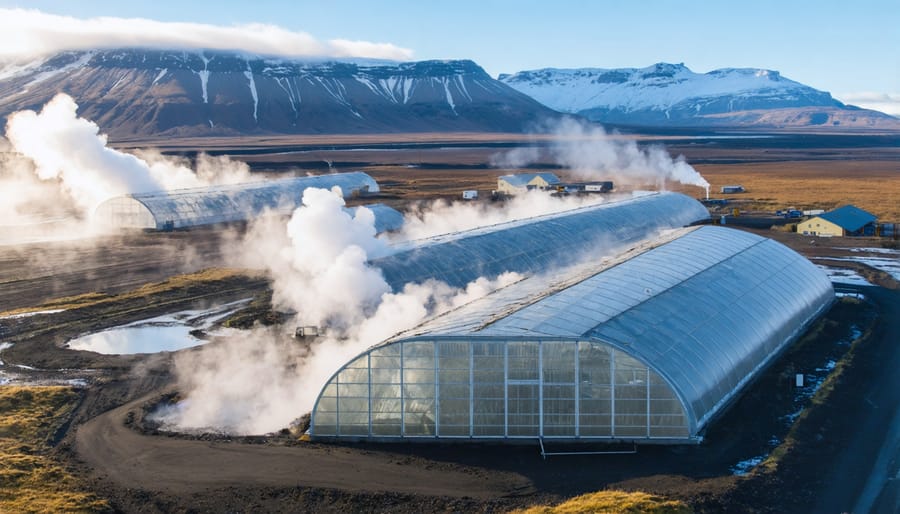
Turkey’s Geothermal Districts
Turkey has emerged as a global leader in agricultural geothermal applications, particularly in greenhouse heating. In the Aegean region, farmers harness geothermal energy to maintain optimal growing conditions year-round, cultivating tomatoes, cucumbers, and other vegetables across more than 4,000 hectares of greenhouse space.
The Denizli and Izmir provinces showcase some of the most successful implementations, where geothermal district heating systems serve both agricultural and residential needs. These systems maintain steady temperatures of 20-25°C in greenhouses during cold months, enabling farmers to extend growing seasons and increase crop yields by up to 40% compared to traditional heating methods.
What’s particularly relevant for Canadian farmers is Turkey’s approach to combining greenhouse operations with geothermal heating in regions with challenging climates. The Simav district, for instance, demonstrates how geothermal resources can support agriculture in areas with temperature fluctuations similar to those experienced in Alberta. Turkish farmers have also developed innovative methods for managing mineral-rich geothermal waters, using heat exchangers to prevent scaling and extend system longevity – techniques that could be valuable for Canadian agricultural operations considering geothermal adoption.
Practical Applications in Canadian Agriculture
Greenhouse Heating Systems
In Canada’s agricultural sector, geothermal greenhouse heating systems are revolutionizing year-round crop production, particularly in regions with harsh winters. These systems harness Earth’s constant underground temperature to maintain optimal growing conditions while significantly reducing energy costs. Many Alberta farmers have discovered that implementing geothermal storage solutions can cut heating expenses by up to 70% compared to traditional methods.
The Lacombe Research Centre in Alberta has demonstrated successful implementation of geothermal greenhouse heating, maintaining consistent temperatures of 18-22°C even during -30°C winter conditions. Their system uses a network of underground pipes filled with a water-glycol mixture, circulating heat from 100 metres below ground to the greenhouse surface.
Local farmer Sarah Thompson from Red Deer County shares, “Since installing our geothermal system three years ago, we’ve extended our growing season by four months and reduced our heating costs by 65%. The initial investment was offset by government incentives and energy savings.”
These systems typically consist of three main components: the ground loop heat exchanger, heat pump, and distribution system. The ground loop can be installed either horizontally (requiring more land area but less expensive) or vertically (requiring less space but higher initial costs). Most Alberta greenhouses opt for vertical systems due to space efficiency and better performance in our climate.
Current estimates suggest that properly maintained geothermal greenhouse systems can operate effectively for 25-30 years, making them a sustainable long-term investment for Canadian agricultural operations.
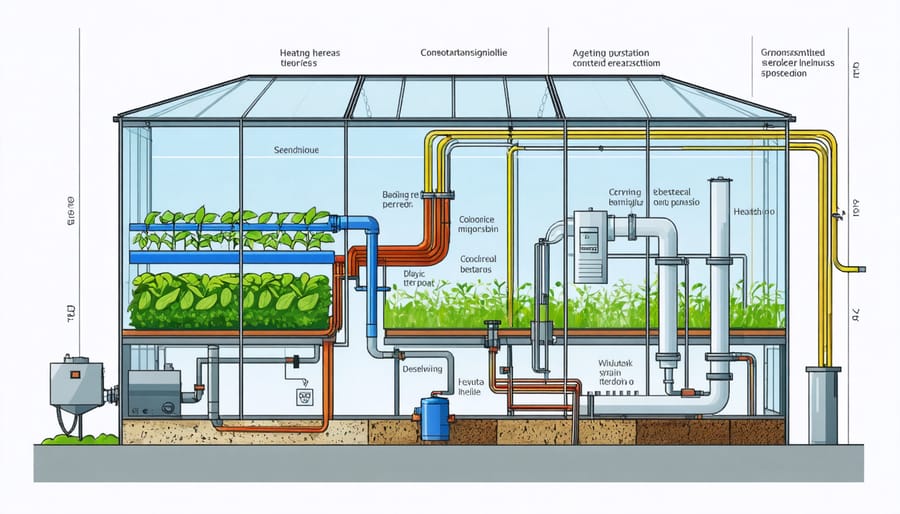
Soil Warming Techniques
In Alberta’s diverse agricultural landscape, farmers are increasingly turning to geothermal soil warming techniques to extend growing seasons and improve crop yields. These methods typically involve installing a network of underground pipes that circulate warm water or antifreeze solutions, maintaining optimal soil temperatures even during colder months.
A popular approach among local producers is the closed-loop system, where pipes are buried about 30-45 centimetres below the surface. This depth has proven effective for most root vegetables and field crops common to our region. The warmed soil creates a microclimate that can extend the growing season by up to six weeks on both ends.
Local farmer Sarah Thompson from Lacombe County shares her success: “Since implementing geothermal soil warming three years ago, we’ve been able to start seeding three weeks earlier and harvest well into October. Our potato yields have increased by 25%.”
The technology is particularly valuable for greenhouse operations, where controlled soil temperatures can support year-round production. Many Alberta greenhouse growers combine soil warming with other geothermal applications, such as space heating, to maximize efficiency.
Installation costs typically range from $15,000 to $30,000 per hectare, but government grants and energy efficiency programs can help offset these initial investments. Most systems pay for themselves within 5-7 years through increased productivity and reduced heating costs.
Remember to consider your specific soil type and crop requirements when planning a geothermal soil warming system, as these factors significantly influence system design and effectiveness.
Alberta’s Geothermal Potential

Current Projects and Success Stories
Alberta’s own Mackenzie County showcases an impressive geothermal greenhouse project that’s revolutionizing year-round crop production. The facility, spanning 2.5 hectares, maintains optimal growing temperatures even during -30°C winters, reducing heating costs by 60% compared to traditional methods.
In Saskatchewan, the DEEP Earth Energy Production project is making waves with its 20-megawatt power facility, providing clean energy to local farming operations while creating sustainable jobs in the agricultural sector. This project demonstrates how geothermal energy can support both power generation and agricultural needs simultaneously.
The Sundre Geothermal Project, led by local farmer Dave Thompson, has successfully integrated ground-source heat pumps to maintain consistent temperatures in his cattle barns. “Our energy costs dropped by 45% in the first year,” Thompson reports, “and our livestock health has improved significantly due to better temperature control.”
These success stories highlight the practical applications of geothermal energy in Canadian agriculture, proving its viability even in our challenging climate. Local farmers are increasingly partnering with renewable energy experts to implement similar systems, creating a growing network of sustainable farming operations.
Future Development Areas
Alberta’s geothermal potential is particularly promising, with several key development areas identified for future projects. The Leduc Formation, known for its historical oil production, shows significant promise for geothermal energy extraction due to its favorable geological conditions and existing well infrastructure. Many of these sustainable farming solutions are already being explored in regions like Grande Prairie and Rocky Mountain House.
Currently, the Alberta No. 1 Geothermal Project near Grande Prairie is leading the way, with plans to provide both heat and power to local agricultural operations by 2025. The project aims to heat 2,500 homes and several greenhouse operations, demonstrating the practical applications for our farming community.
In the Municipal District of Greenview, developers are working on a 300-megawatt geothermal power plant that could support year-round greenhouse operations and aquaculture facilities. This project represents a significant step forward in making geothermal energy accessible to Alberta farmers, particularly those looking to extend their growing seasons and diversify their operations.
Implementation Considerations for Canadian Farmers
Cost-Benefit Analysis
The economic benefits of geothermal energy in agriculture often outweigh initial installation costs, particularly when integrated with other sustainable agricultural practices. In Alberta, farmers can access various support programs, including the Canadian Agricultural Partnership (CAP) grants, which can cover up to 30% of installation costs. The average payback period for agricultural geothermal systems ranges from 3-7 years, with annual energy savings of 40-60% compared to conventional heating methods. Operating costs typically run 25-50% lower than traditional systems, while maintenance requirements remain minimal. Government incentives, combined with rising energy costs, make geothermal increasingly attractive for greenhouse operations and livestock facilities. Local success stories show that farms implementing geothermal solutions have reduced their carbon footprint while improving their bottom line through decreased operational expenses and increased crop yields.
Technical Requirements
To harness geothermal energy effectively, specific technical requirements must be in place. The primary infrastructure includes a reliable well system, typically ranging from 150 to 300 metres deep for agricultural applications in Alberta. Heat exchangers and pumping systems are essential components, with modern installations requiring backup power systems to ensure continuous operation.
For greenhouse operations, automated climate control systems and temperature monitoring equipment are necessary. Professional expertise is crucial, including certified geothermal technicians, drilling specialists, and agricultural engineers who understand both geothermal systems and crop requirements.
Farms need adequate electrical infrastructure to support the pumping systems, typically requiring 3-phase power access. Water quality monitoring equipment is essential, as mineral content can affect system efficiency. Regular maintenance schedules and backup heating systems are recommended for our Canadian climate, ensuring continuous operation during peak growing seasons.
Proper insulation and distribution systems are vital, particularly in greenhouse applications where heat must be evenly distributed to maintain consistent growing conditions.
Geothermal energy continues to show remarkable potential for Canadian agriculture, particularly in Alberta where our unique geological conditions offer substantial opportunities. As we’ve seen from successful implementations worldwide, this sustainable energy source can significantly reduce operational costs while supporting year-round growing capabilities. Looking ahead, experts predict increased adoption of geothermal solutions across Canadian farms, supported by improving technology and growing government incentives. The combination of environmental benefits and economic advantages makes geothermal energy an increasingly attractive option for our agricultural community. By learning from global leaders like Iceland and New Zealand, while adapting solutions to our local conditions, Canadian farmers are well-positioned to harness this reliable, clean energy source. As we move forward, collaboration between farmers, researchers, and industry experts will be crucial in expanding geothermal applications across our agricultural landscape.

